Comprehensive Research Report: Product Element of Marketing Mix
VerifiedAdded on 2022/04/28
|18
|4235
|55
Report
AI Summary
This report provides a comprehensive analysis of the product element within the marketing mix. It begins by defining a product and its core attributes, differentiating between tangible and intangible aspects. The report then delves into the components of a product, including the core, generic, augmented, and potential product levels, before proceeding to classify products into consumer and industrial categories, detailing the sub-categories within each (e.g., convenience, shopping, specialty, and unsought products for consumer products; installations, accessories, raw materials, components, and supplies for industrial products). A significant portion of the report is dedicated to the product life cycle (PLC), outlining its stages (introduction, growth, maturity, and decline), and the marketing strategies appropriate for each stage, including pricing and promotion. The report concludes with a discussion of the advantages and disadvantages of the PLC model. Furthermore, the document explores the product mix, defining its components (product line, item, width, depth, and length) and strategies for extending it, such as introducing new models or complementary items. Overall, the report provides a detailed overview of product-related marketing concepts and strategies.
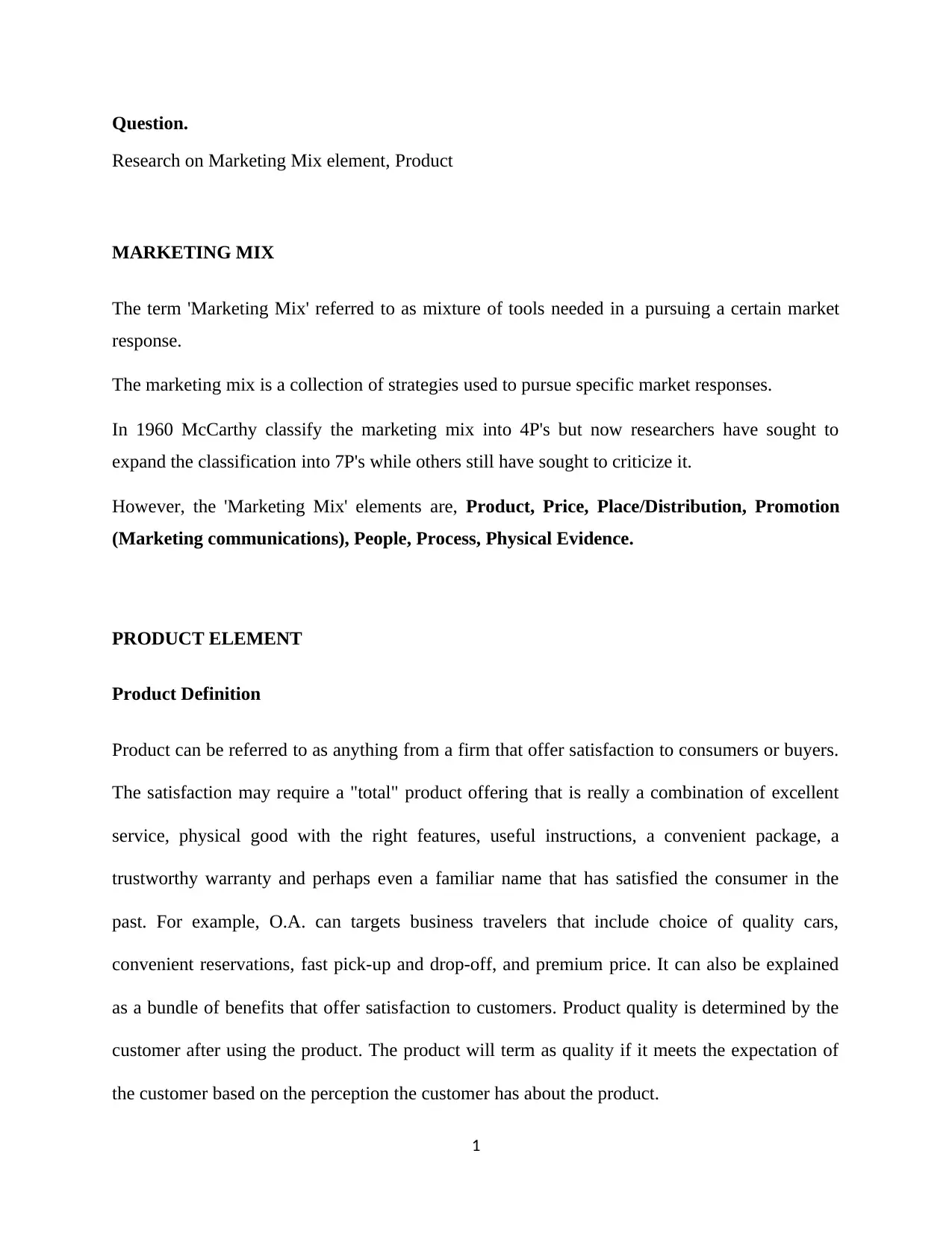
Question.
Research on Marketing Mix element, Product
MARKETING MIX
The term 'Marketing Mix' referred to as mixture of tools needed in a pursuing a certain market
response.
The marketing mix is a collection of strategies used to pursue specific market responses.
In 1960 McCarthy classify the marketing mix into 4P's but now researchers have sought to
expand the classification into 7P's while others still have sought to criticize it.
However, the 'Marketing Mix' elements are, Product, Price, Place/Distribution, Promotion
(Marketing communications), People, Process, Physical Evidence.
PRODUCT ELEMENT
Product Definition
Product can be referred to as anything from a firm that offer satisfaction to consumers or buyers.
The satisfaction may require a "total" product offering that is really a combination of excellent
service, physical good with the right features, useful instructions, a convenient package, a
trustworthy warranty and perhaps even a familiar name that has satisfied the consumer in the
past. For example, O.A. can targets business travelers that include choice of quality cars,
convenient reservations, fast pick-up and drop-off, and premium price. It can also be explained
as a bundle of benefits that offer satisfaction to customers. Product quality is determined by the
customer after using the product. The product will term as quality if it meets the expectation of
the customer based on the perception the customer has about the product.
1
Research on Marketing Mix element, Product
MARKETING MIX
The term 'Marketing Mix' referred to as mixture of tools needed in a pursuing a certain market
response.
The marketing mix is a collection of strategies used to pursue specific market responses.
In 1960 McCarthy classify the marketing mix into 4P's but now researchers have sought to
expand the classification into 7P's while others still have sought to criticize it.
However, the 'Marketing Mix' elements are, Product, Price, Place/Distribution, Promotion
(Marketing communications), People, Process, Physical Evidence.
PRODUCT ELEMENT
Product Definition
Product can be referred to as anything from a firm that offer satisfaction to consumers or buyers.
The satisfaction may require a "total" product offering that is really a combination of excellent
service, physical good with the right features, useful instructions, a convenient package, a
trustworthy warranty and perhaps even a familiar name that has satisfied the consumer in the
past. For example, O.A. can targets business travelers that include choice of quality cars,
convenient reservations, fast pick-up and drop-off, and premium price. It can also be explained
as a bundle of benefits that offer satisfaction to customers. Product quality is determined by the
customer after using the product. The product will term as quality if it meets the expectation of
the customer based on the perception the customer has about the product.
1
Paraphrase This Document
Need a fresh take? Get an instant paraphrase of this document with our AI Paraphraser
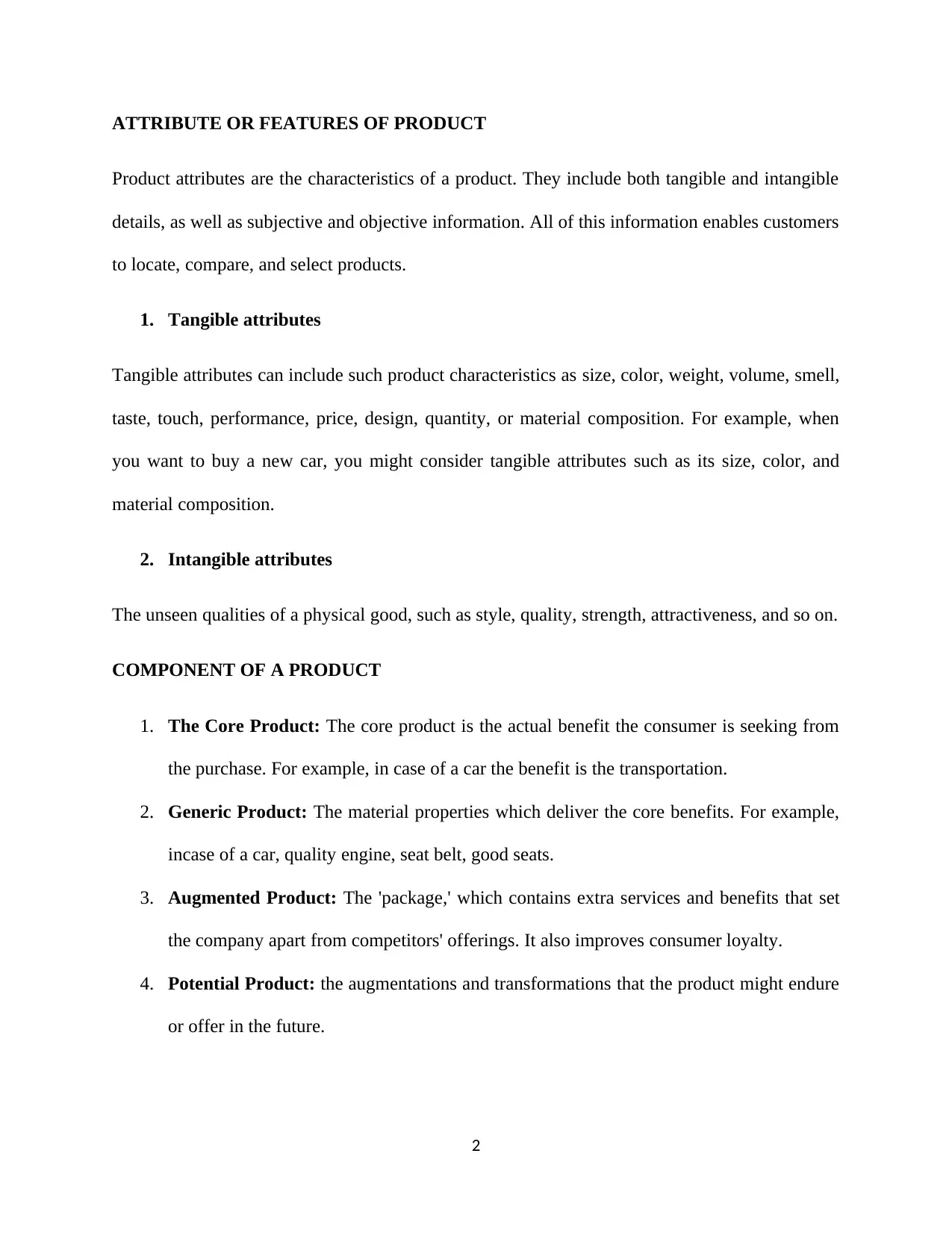
ATTRIBUTE OR FEATURES OF PRODUCT
Product attributes are the characteristics of a product. They include both tangible and intangible
details, as well as subjective and objective information. All of this information enables customers
to locate, compare, and select products.
1. Tangible attributes
Tangible attributes can include such product characteristics as size, color, weight, volume, smell,
taste, touch, performance, price, design, quantity, or material composition. For example, when
you want to buy a new car, you might consider tangible attributes such as its size, color, and
material composition.
2. Intangible attributes
The unseen qualities of a physical good, such as style, quality, strength, attractiveness, and so on.
COMPONENT OF A PRODUCT
1. The Core Product: The core product is the actual benefit the consumer is seeking from
the purchase. For example, in case of a car the benefit is the transportation.
2. Generic Product: The material properties which deliver the core benefits. For example,
incase of a car, quality engine, seat belt, good seats.
3. Augmented Product: The 'package,' which contains extra services and benefits that set
the company apart from competitors' offerings. It also improves consumer loyalty.
4. Potential Product: the augmentations and transformations that the product might endure
or offer in the future.
2
Product attributes are the characteristics of a product. They include both tangible and intangible
details, as well as subjective and objective information. All of this information enables customers
to locate, compare, and select products.
1. Tangible attributes
Tangible attributes can include such product characteristics as size, color, weight, volume, smell,
taste, touch, performance, price, design, quantity, or material composition. For example, when
you want to buy a new car, you might consider tangible attributes such as its size, color, and
material composition.
2. Intangible attributes
The unseen qualities of a physical good, such as style, quality, strength, attractiveness, and so on.
COMPONENT OF A PRODUCT
1. The Core Product: The core product is the actual benefit the consumer is seeking from
the purchase. For example, in case of a car the benefit is the transportation.
2. Generic Product: The material properties which deliver the core benefits. For example,
incase of a car, quality engine, seat belt, good seats.
3. Augmented Product: The 'package,' which contains extra services and benefits that set
the company apart from competitors' offerings. It also improves consumer loyalty.
4. Potential Product: the augmentations and transformations that the product might endure
or offer in the future.
2
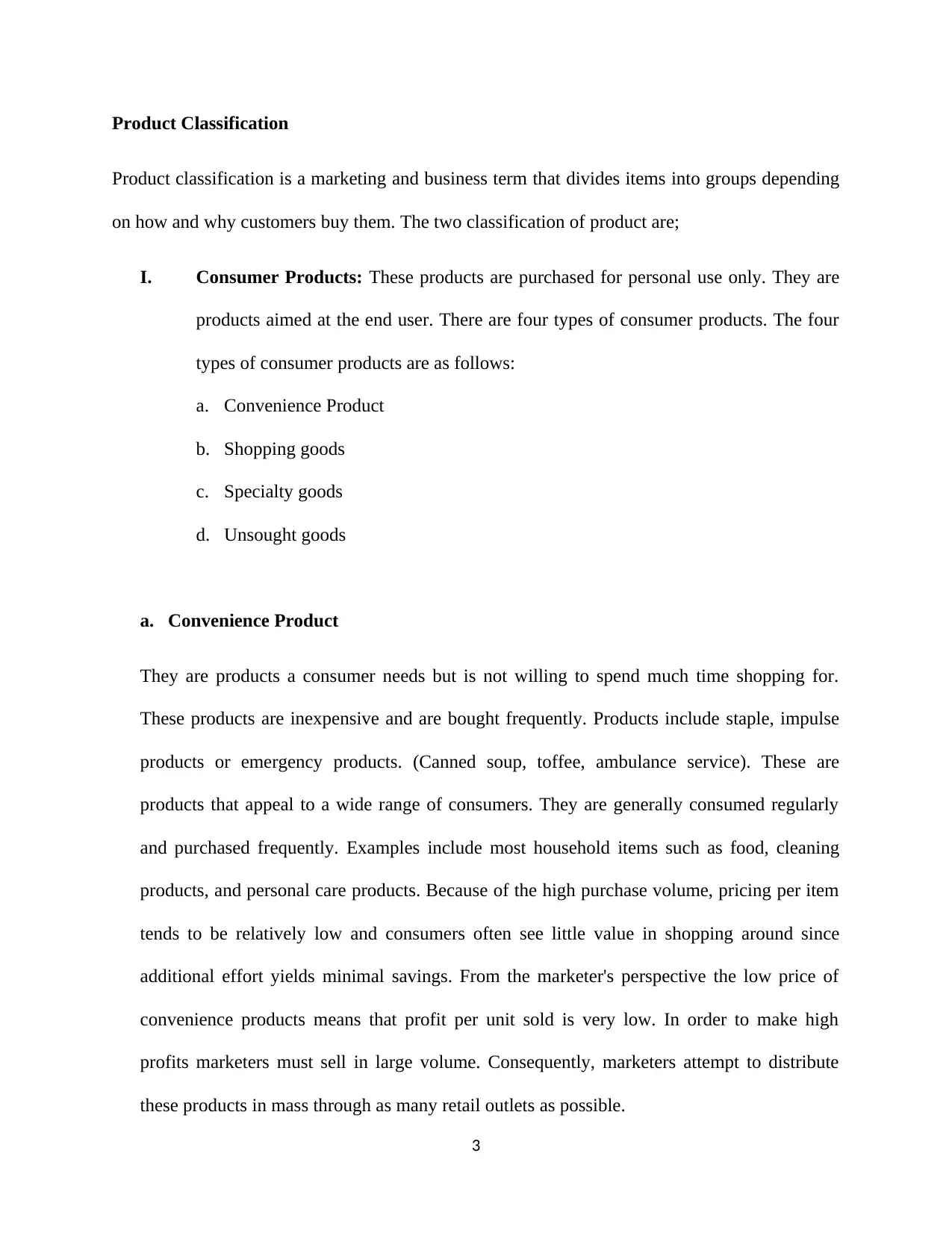
Product Classification
Product classification is a marketing and business term that divides items into groups depending
on how and why customers buy them. The two classification of product are;
I. Consumer Products: These products are purchased for personal use only. They are
products aimed at the end user. There are four types of consumer products. The four
types of consumer products are as follows:
a. Convenience Product
b. Shopping goods
c. Specialty goods
d. Unsought goods
a. Convenience Product
They are products a consumer needs but is not willing to spend much time shopping for.
These products are inexpensive and are bought frequently. Products include staple, impulse
products or emergency products. (Canned soup, toffee, ambulance service). These are
products that appeal to a wide range of consumers. They are generally consumed regularly
and purchased frequently. Examples include most household items such as food, cleaning
products, and personal care products. Because of the high purchase volume, pricing per item
tends to be relatively low and consumers often see little value in shopping around since
additional effort yields minimal savings. From the marketer's perspective the low price of
convenience products means that profit per unit sold is very low. In order to make high
profits marketers must sell in large volume. Consequently, marketers attempt to distribute
these products in mass through as many retail outlets as possible.
3
Product classification is a marketing and business term that divides items into groups depending
on how and why customers buy them. The two classification of product are;
I. Consumer Products: These products are purchased for personal use only. They are
products aimed at the end user. There are four types of consumer products. The four
types of consumer products are as follows:
a. Convenience Product
b. Shopping goods
c. Specialty goods
d. Unsought goods
a. Convenience Product
They are products a consumer needs but is not willing to spend much time shopping for.
These products are inexpensive and are bought frequently. Products include staple, impulse
products or emergency products. (Canned soup, toffee, ambulance service). These are
products that appeal to a wide range of consumers. They are generally consumed regularly
and purchased frequently. Examples include most household items such as food, cleaning
products, and personal care products. Because of the high purchase volume, pricing per item
tends to be relatively low and consumers often see little value in shopping around since
additional effort yields minimal savings. From the marketer's perspective the low price of
convenience products means that profit per unit sold is very low. In order to make high
profits marketers must sell in large volume. Consequently, marketers attempt to distribute
these products in mass through as many retail outlets as possible.
3
⊘ This is a preview!⊘
Do you want full access?
Subscribe today to unlock all pages.

Trusted by 1+ million students worldwide
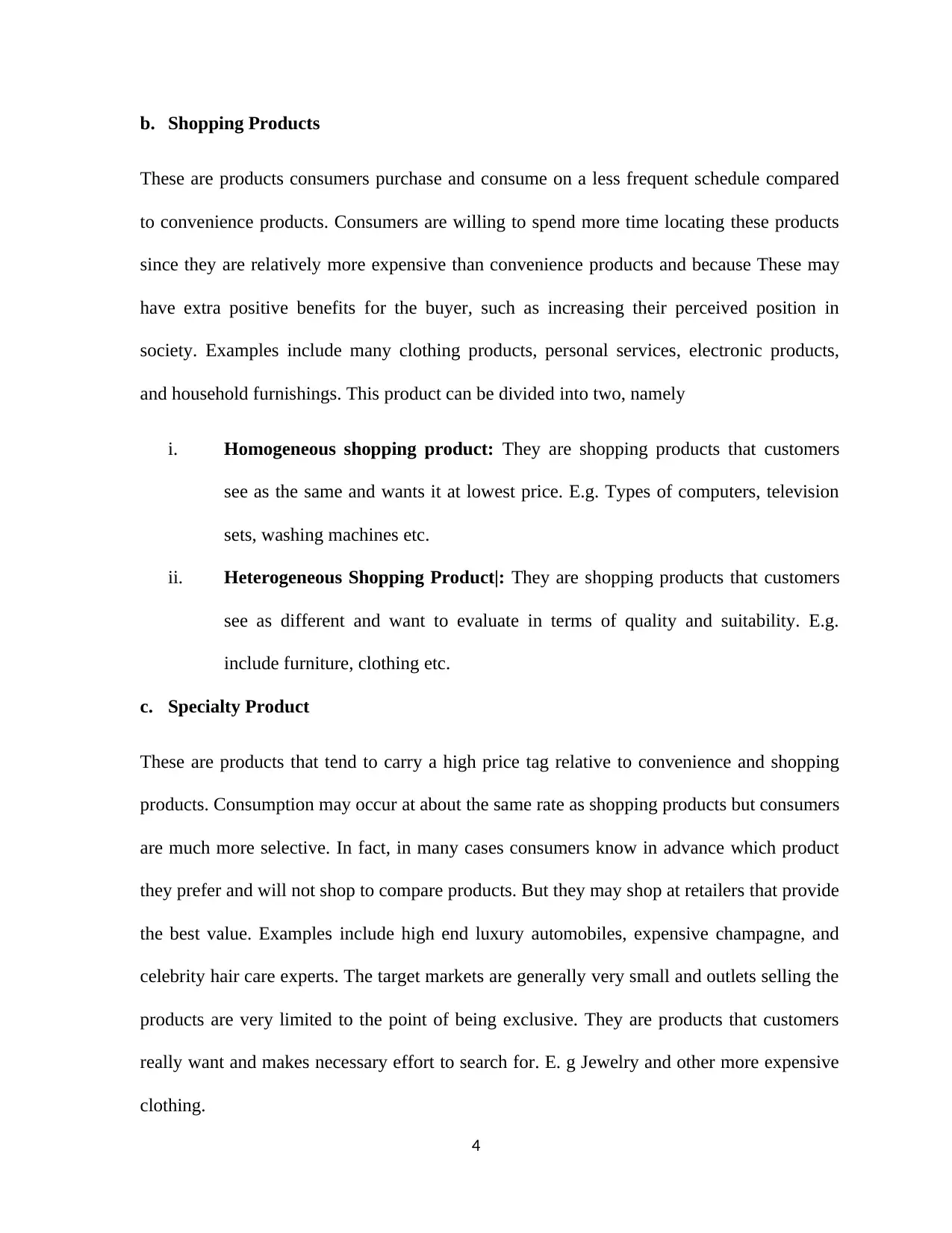
b. Shopping Products
These are products consumers purchase and consume on a less frequent schedule compared
to convenience products. Consumers are willing to spend more time locating these products
since they are relatively more expensive than convenience products and because These may
have extra positive benefits for the buyer, such as increasing their perceived position in
society. Examples include many clothing products, personal services, electronic products,
and household furnishings. This product can be divided into two, namely
i. Homogeneous shopping product: They are shopping products that customers
see as the same and wants it at lowest price. E.g. Types of computers, television
sets, washing machines etc.
ii. Heterogeneous Shopping Product|: They are shopping products that customers
see as different and want to evaluate in terms of quality and suitability. E.g.
include furniture, clothing etc.
c. Specialty Product
These are products that tend to carry a high price tag relative to convenience and shopping
products. Consumption may occur at about the same rate as shopping products but consumers
are much more selective. In fact, in many cases consumers know in advance which product
they prefer and will not shop to compare products. But they may shop at retailers that provide
the best value. Examples include high end luxury automobiles, expensive champagne, and
celebrity hair care experts. The target markets are generally very small and outlets selling the
products are very limited to the point of being exclusive. They are products that customers
really want and makes necessary effort to search for. E. g Jewelry and other more expensive
clothing.
4
These are products consumers purchase and consume on a less frequent schedule compared
to convenience products. Consumers are willing to spend more time locating these products
since they are relatively more expensive than convenience products and because These may
have extra positive benefits for the buyer, such as increasing their perceived position in
society. Examples include many clothing products, personal services, electronic products,
and household furnishings. This product can be divided into two, namely
i. Homogeneous shopping product: They are shopping products that customers
see as the same and wants it at lowest price. E.g. Types of computers, television
sets, washing machines etc.
ii. Heterogeneous Shopping Product|: They are shopping products that customers
see as different and want to evaluate in terms of quality and suitability. E.g.
include furniture, clothing etc.
c. Specialty Product
These are products that tend to carry a high price tag relative to convenience and shopping
products. Consumption may occur at about the same rate as shopping products but consumers
are much more selective. In fact, in many cases consumers know in advance which product
they prefer and will not shop to compare products. But they may shop at retailers that provide
the best value. Examples include high end luxury automobiles, expensive champagne, and
celebrity hair care experts. The target markets are generally very small and outlets selling the
products are very limited to the point of being exclusive. They are products that customers
really want and makes necessary effort to search for. E. g Jewelry and other more expensive
clothing.
4
Paraphrase This Document
Need a fresh take? Get an instant paraphrase of this document with our AI Paraphraser
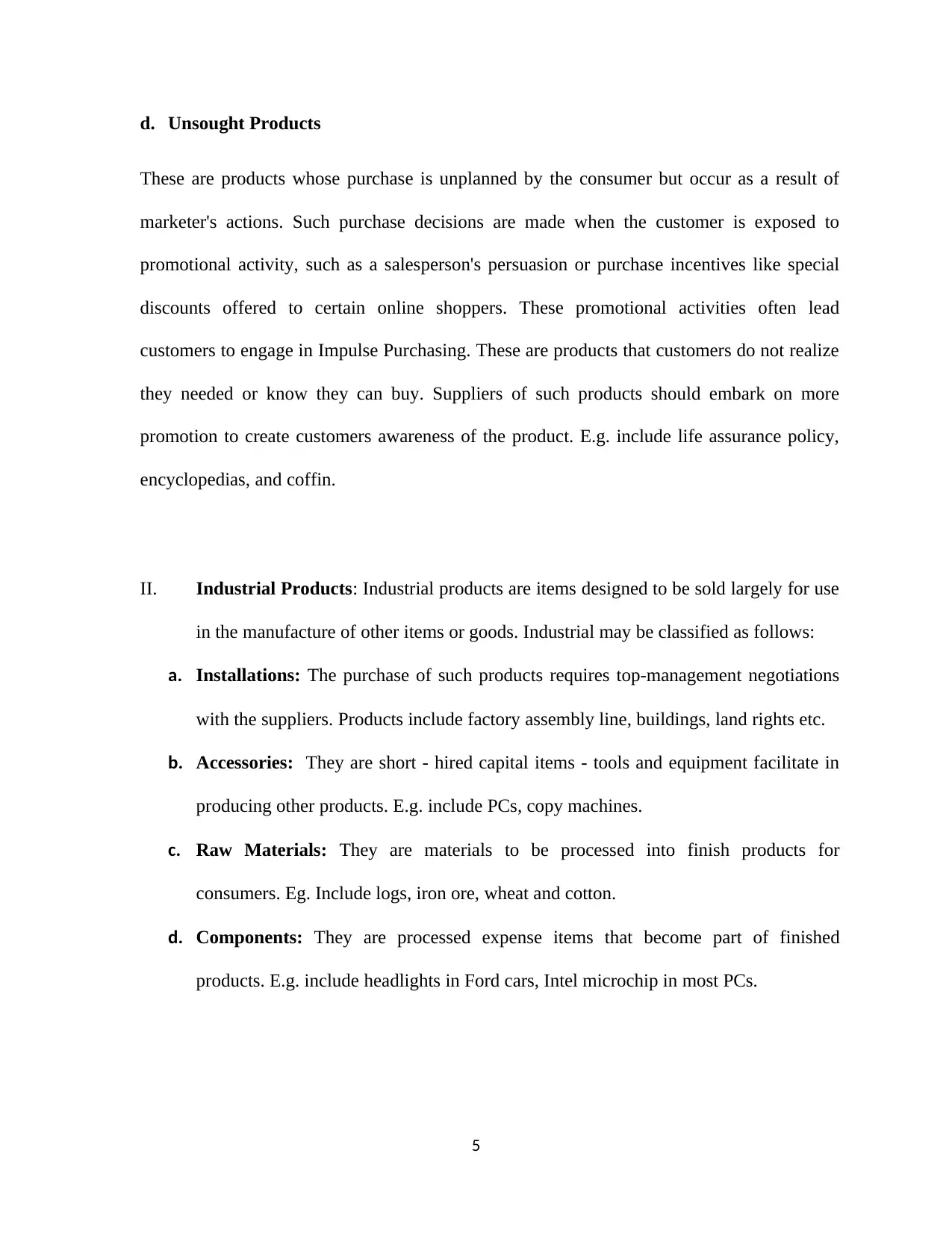
d. Unsought Products
These are products whose purchase is unplanned by the consumer but occur as a result of
marketer's actions. Such purchase decisions are made when the customer is exposed to
promotional activity, such as a salesperson's persuasion or purchase incentives like special
discounts offered to certain online shoppers. These promotional activities often lead
customers to engage in Impulse Purchasing. These are products that customers do not realize
they needed or know they can buy. Suppliers of such products should embark on more
promotion to create customers awareness of the product. E.g. include life assurance policy,
encyclopedias, and coffin.
II. Industrial Products: Industrial products are items designed to be sold largely for use
in the manufacture of other items or goods. Industrial may be classified as follows:
a. Installations: The purchase of such products requires top-management negotiations
with the suppliers. Products include factory assembly line, buildings, land rights etc.
b. Accessories: They are short - hired capital items - tools and equipment facilitate in
producing other products. E.g. include PCs, copy machines.
c. Raw Materials: They are materials to be processed into finish products for
consumers. Eg. Include logs, iron ore, wheat and cotton.
d. Components: They are processed expense items that become part of finished
products. E.g. include headlights in Ford cars, Intel microchip in most PCs.
5
These are products whose purchase is unplanned by the consumer but occur as a result of
marketer's actions. Such purchase decisions are made when the customer is exposed to
promotional activity, such as a salesperson's persuasion or purchase incentives like special
discounts offered to certain online shoppers. These promotional activities often lead
customers to engage in Impulse Purchasing. These are products that customers do not realize
they needed or know they can buy. Suppliers of such products should embark on more
promotion to create customers awareness of the product. E.g. include life assurance policy,
encyclopedias, and coffin.
II. Industrial Products: Industrial products are items designed to be sold largely for use
in the manufacture of other items or goods. Industrial may be classified as follows:
a. Installations: The purchase of such products requires top-management negotiations
with the suppliers. Products include factory assembly line, buildings, land rights etc.
b. Accessories: They are short - hired capital items - tools and equipment facilitate in
producing other products. E.g. include PCs, copy machines.
c. Raw Materials: They are materials to be processed into finish products for
consumers. Eg. Include logs, iron ore, wheat and cotton.
d. Components: They are processed expense items that become part of finished
products. E.g. include headlights in Ford cars, Intel microchip in most PCs.
5
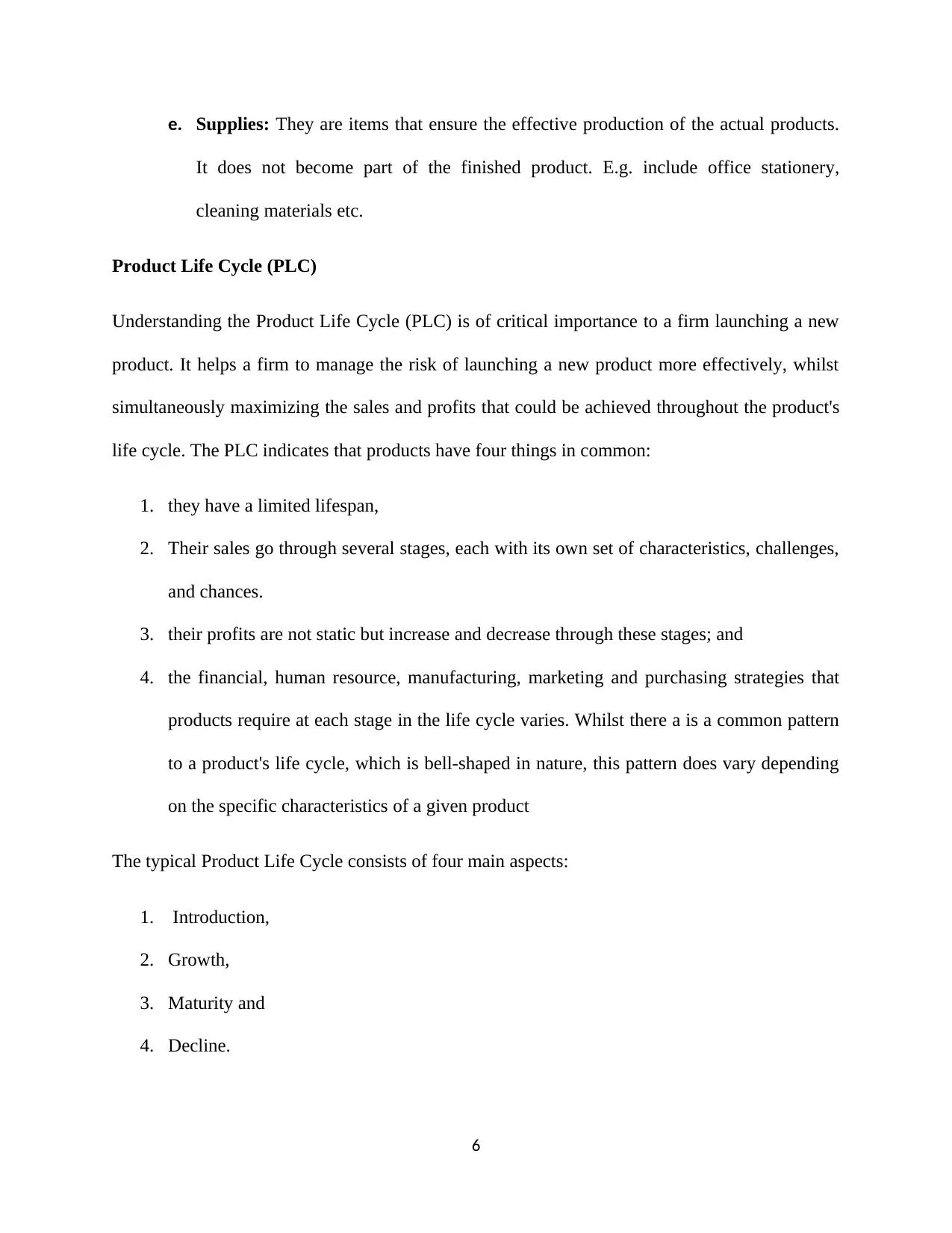
e. Supplies: They are items that ensure the effective production of the actual products.
It does not become part of the finished product. E.g. include office stationery,
cleaning materials etc.
Product Life Cycle (PLC)
Understanding the Product Life Cycle (PLC) is of critical importance to a firm launching a new
product. It helps a firm to manage the risk of launching a new product more effectively, whilst
simultaneously maximizing the sales and profits that could be achieved throughout the product's
life cycle. The PLC indicates that products have four things in common:
1. they have a limited lifespan,
2. Their sales go through several stages, each with its own set of characteristics, challenges,
and chances.
3. their profits are not static but increase and decrease through these stages; and
4. the financial, human resource, manufacturing, marketing and purchasing strategies that
products require at each stage in the life cycle varies. Whilst there a is a common pattern
to a product's life cycle, which is bell-shaped in nature, this pattern does vary depending
on the specific characteristics of a given product
The typical Product Life Cycle consists of four main aspects:
1. Introduction,
2. Growth,
3. Maturity and
4. Decline.
6
It does not become part of the finished product. E.g. include office stationery,
cleaning materials etc.
Product Life Cycle (PLC)
Understanding the Product Life Cycle (PLC) is of critical importance to a firm launching a new
product. It helps a firm to manage the risk of launching a new product more effectively, whilst
simultaneously maximizing the sales and profits that could be achieved throughout the product's
life cycle. The PLC indicates that products have four things in common:
1. they have a limited lifespan,
2. Their sales go through several stages, each with its own set of characteristics, challenges,
and chances.
3. their profits are not static but increase and decrease through these stages; and
4. the financial, human resource, manufacturing, marketing and purchasing strategies that
products require at each stage in the life cycle varies. Whilst there a is a common pattern
to a product's life cycle, which is bell-shaped in nature, this pattern does vary depending
on the specific characteristics of a given product
The typical Product Life Cycle consists of four main aspects:
1. Introduction,
2. Growth,
3. Maturity and
4. Decline.
6
⊘ This is a preview!⊘
Do you want full access?
Subscribe today to unlock all pages.

Trusted by 1+ million students worldwide
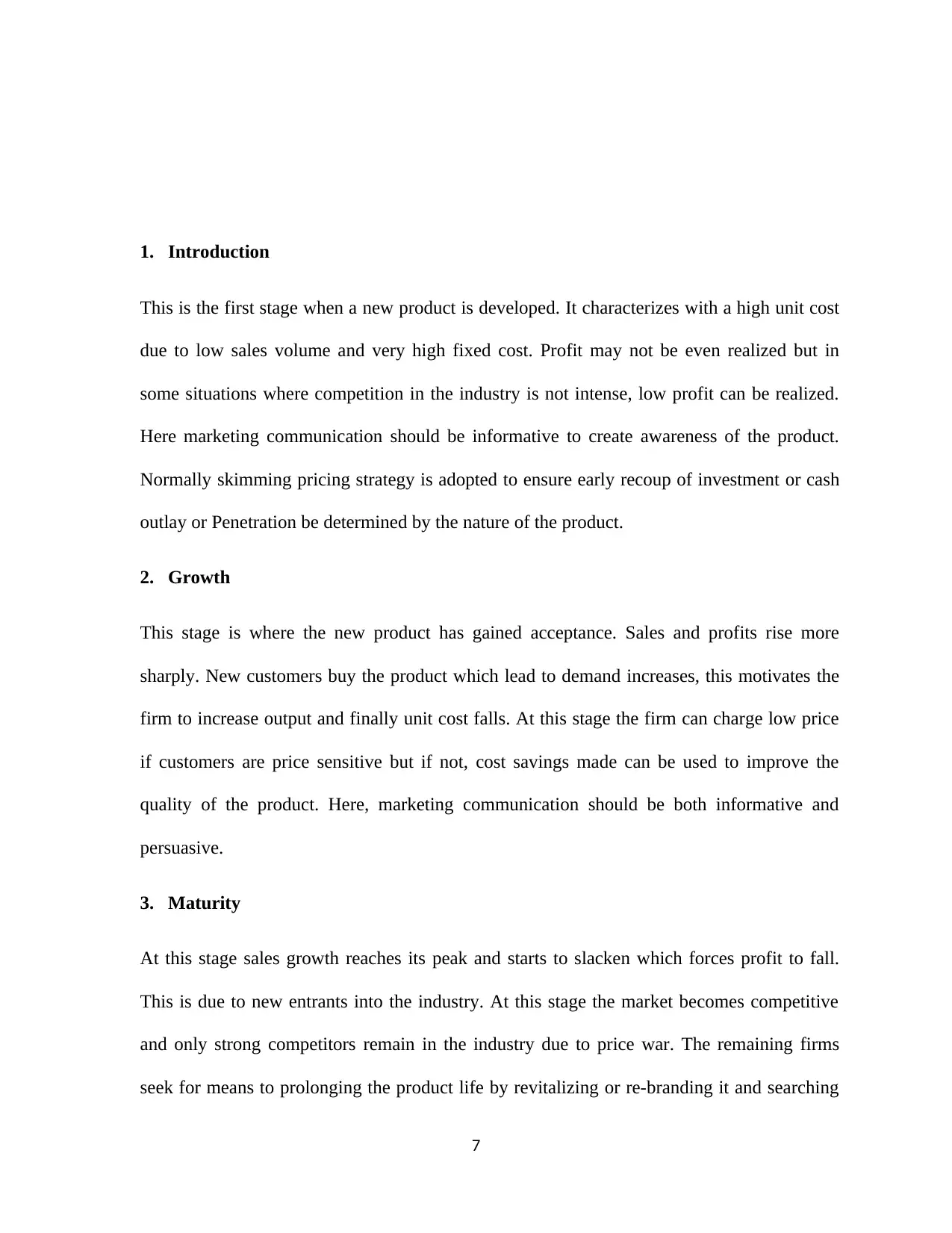
1. Introduction
This is the first stage when a new product is developed. It characterizes with a high unit cost
due to low sales volume and very high fixed cost. Profit may not be even realized but in
some situations where competition in the industry is not intense, low profit can be realized.
Here marketing communication should be informative to create awareness of the product.
Normally skimming pricing strategy is adopted to ensure early recoup of investment or cash
outlay or Penetration be determined by the nature of the product.
2. Growth
This stage is where the new product has gained acceptance. Sales and profits rise more
sharply. New customers buy the product which lead to demand increases, this motivates the
firm to increase output and finally unit cost falls. At this stage the firm can charge low price
if customers are price sensitive but if not, cost savings made can be used to improve the
quality of the product. Here, marketing communication should be both informative and
persuasive.
3. Maturity
At this stage sales growth reaches its peak and starts to slacken which forces profit to fall.
This is due to new entrants into the industry. At this stage the market becomes competitive
and only strong competitors remain in the industry due to price war. The remaining firms
seek for means to prolonging the product life by revitalizing or re-branding it and searching
7
This is the first stage when a new product is developed. It characterizes with a high unit cost
due to low sales volume and very high fixed cost. Profit may not be even realized but in
some situations where competition in the industry is not intense, low profit can be realized.
Here marketing communication should be informative to create awareness of the product.
Normally skimming pricing strategy is adopted to ensure early recoup of investment or cash
outlay or Penetration be determined by the nature of the product.
2. Growth
This stage is where the new product has gained acceptance. Sales and profits rise more
sharply. New customers buy the product which lead to demand increases, this motivates the
firm to increase output and finally unit cost falls. At this stage the firm can charge low price
if customers are price sensitive but if not, cost savings made can be used to improve the
quality of the product. Here, marketing communication should be both informative and
persuasive.
3. Maturity
At this stage sales growth reaches its peak and starts to slacken which forces profit to fall.
This is due to new entrants into the industry. At this stage the market becomes competitive
and only strong competitors remain in the industry due to price war. The remaining firms
seek for means to prolonging the product life by revitalizing or re-branding it and searching
7
Paraphrase This Document
Need a fresh take? Get an instant paraphrase of this document with our AI Paraphraser
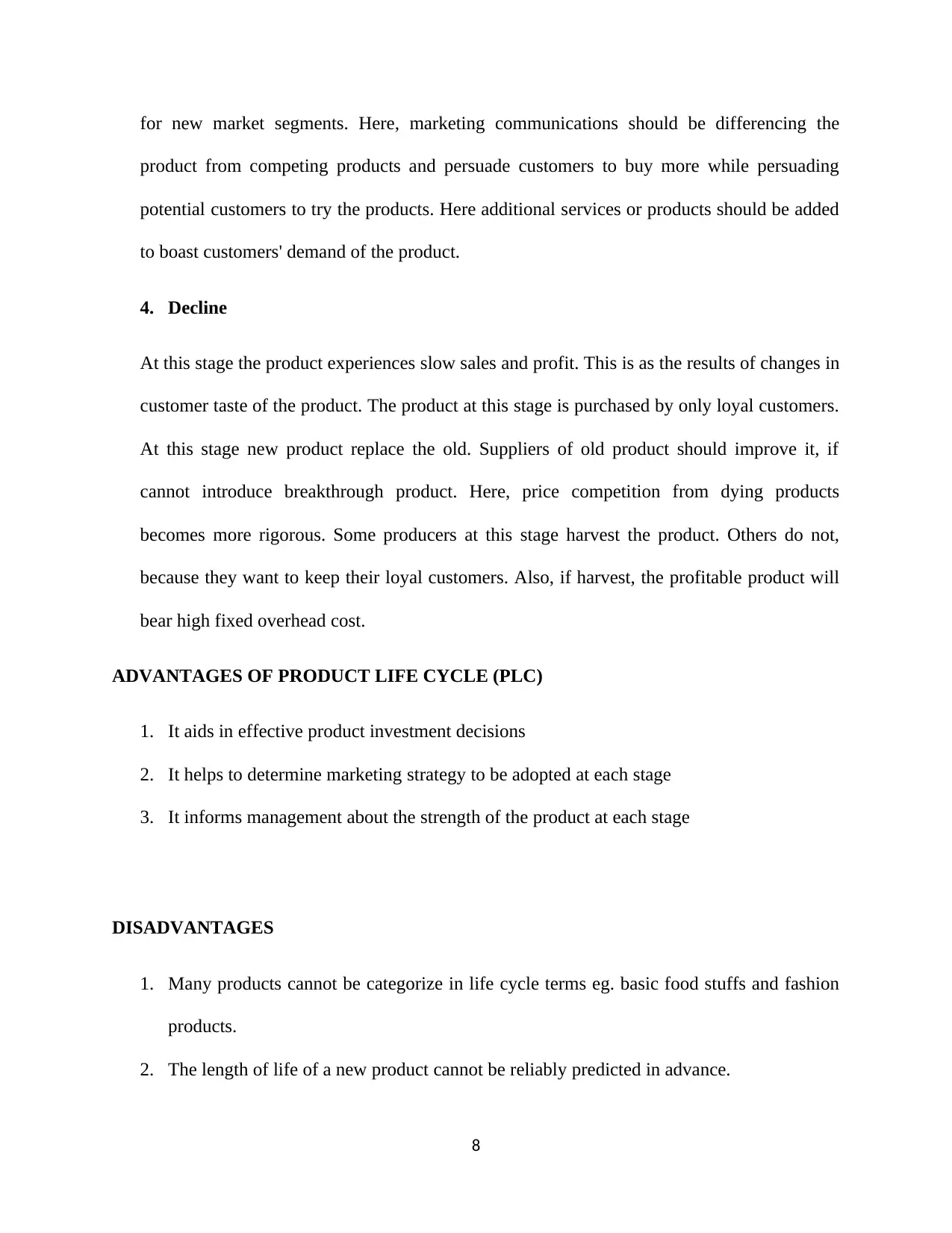
for new market segments. Here, marketing communications should be differencing the
product from competing products and persuade customers to buy more while persuading
potential customers to try the products. Here additional services or products should be added
to boast customers' demand of the product.
4. Decline
At this stage the product experiences slow sales and profit. This is as the results of changes in
customer taste of the product. The product at this stage is purchased by only loyal customers.
At this stage new product replace the old. Suppliers of old product should improve it, if
cannot introduce breakthrough product. Here, price competition from dying products
becomes more rigorous. Some producers at this stage harvest the product. Others do not,
because they want to keep their loyal customers. Also, if harvest, the profitable product will
bear high fixed overhead cost.
ADVANTAGES OF PRODUCT LIFE CYCLE (PLC)
1. It aids in effective product investment decisions
2. It helps to determine marketing strategy to be adopted at each stage
3. It informs management about the strength of the product at each stage
DISADVANTAGES
1. Many products cannot be categorize in life cycle terms eg. basic food stuffs and fashion
products.
2. The length of life of a new product cannot be reliably predicted in advance.
8
product from competing products and persuade customers to buy more while persuading
potential customers to try the products. Here additional services or products should be added
to boast customers' demand of the product.
4. Decline
At this stage the product experiences slow sales and profit. This is as the results of changes in
customer taste of the product. The product at this stage is purchased by only loyal customers.
At this stage new product replace the old. Suppliers of old product should improve it, if
cannot introduce breakthrough product. Here, price competition from dying products
becomes more rigorous. Some producers at this stage harvest the product. Others do not,
because they want to keep their loyal customers. Also, if harvest, the profitable product will
bear high fixed overhead cost.
ADVANTAGES OF PRODUCT LIFE CYCLE (PLC)
1. It aids in effective product investment decisions
2. It helps to determine marketing strategy to be adopted at each stage
3. It informs management about the strength of the product at each stage
DISADVANTAGES
1. Many products cannot be categorize in life cycle terms eg. basic food stuffs and fashion
products.
2. The length of life of a new product cannot be reliably predicted in advance.
8
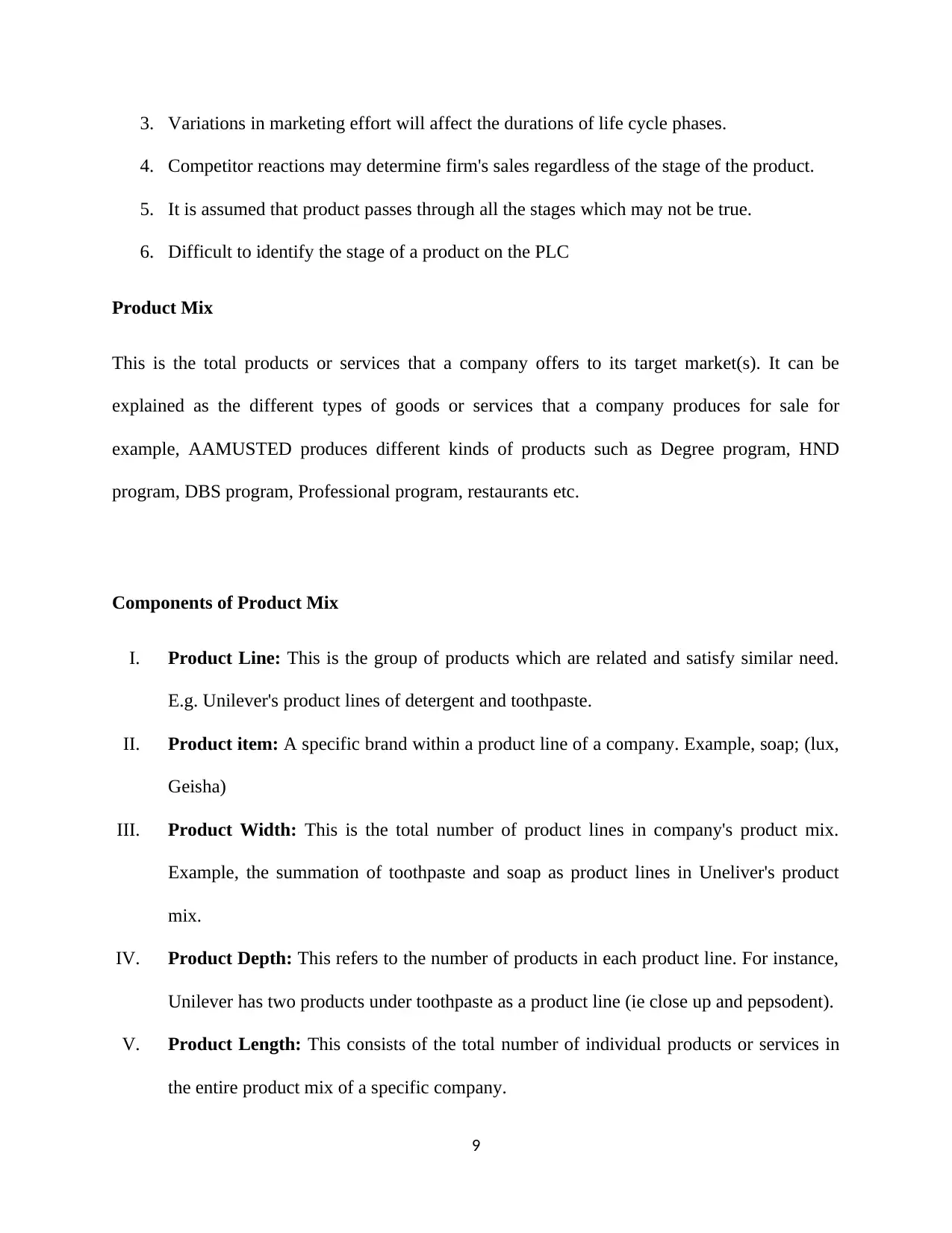
3. Variations in marketing effort will affect the durations of life cycle phases.
4. Competitor reactions may determine firm's sales regardless of the stage of the product.
5. It is assumed that product passes through all the stages which may not be true.
6. Difficult to identify the stage of a product on the PLC
Product Mix
This is the total products or services that a company offers to its target market(s). It can be
explained as the different types of goods or services that a company produces for sale for
example, AAMUSTED produces different kinds of products such as Degree program, HND
program, DBS program, Professional program, restaurants etc.
Components of Product Mix
I. Product Line: This is the group of products which are related and satisfy similar need.
E.g. Unilever's product lines of detergent and toothpaste.
II. Product item: A specific brand within a product line of a company. Example, soap; (lux,
Geisha)
III. Product Width: This is the total number of product lines in company's product mix.
Example, the summation of toothpaste and soap as product lines in Uneliver's product
mix.
IV. Product Depth: This refers to the number of products in each product line. For instance,
Unilever has two products under toothpaste as a product line (ie close up and pepsodent).
V. Product Length: This consists of the total number of individual products or services in
the entire product mix of a specific company.
9
4. Competitor reactions may determine firm's sales regardless of the stage of the product.
5. It is assumed that product passes through all the stages which may not be true.
6. Difficult to identify the stage of a product on the PLC
Product Mix
This is the total products or services that a company offers to its target market(s). It can be
explained as the different types of goods or services that a company produces for sale for
example, AAMUSTED produces different kinds of products such as Degree program, HND
program, DBS program, Professional program, restaurants etc.
Components of Product Mix
I. Product Line: This is the group of products which are related and satisfy similar need.
E.g. Unilever's product lines of detergent and toothpaste.
II. Product item: A specific brand within a product line of a company. Example, soap; (lux,
Geisha)
III. Product Width: This is the total number of product lines in company's product mix.
Example, the summation of toothpaste and soap as product lines in Uneliver's product
mix.
IV. Product Depth: This refers to the number of products in each product line. For instance,
Unilever has two products under toothpaste as a product line (ie close up and pepsodent).
V. Product Length: This consists of the total number of individual products or services in
the entire product mix of a specific company.
9
⊘ This is a preview!⊘
Do you want full access?
Subscribe today to unlock all pages.

Trusted by 1+ million students worldwide
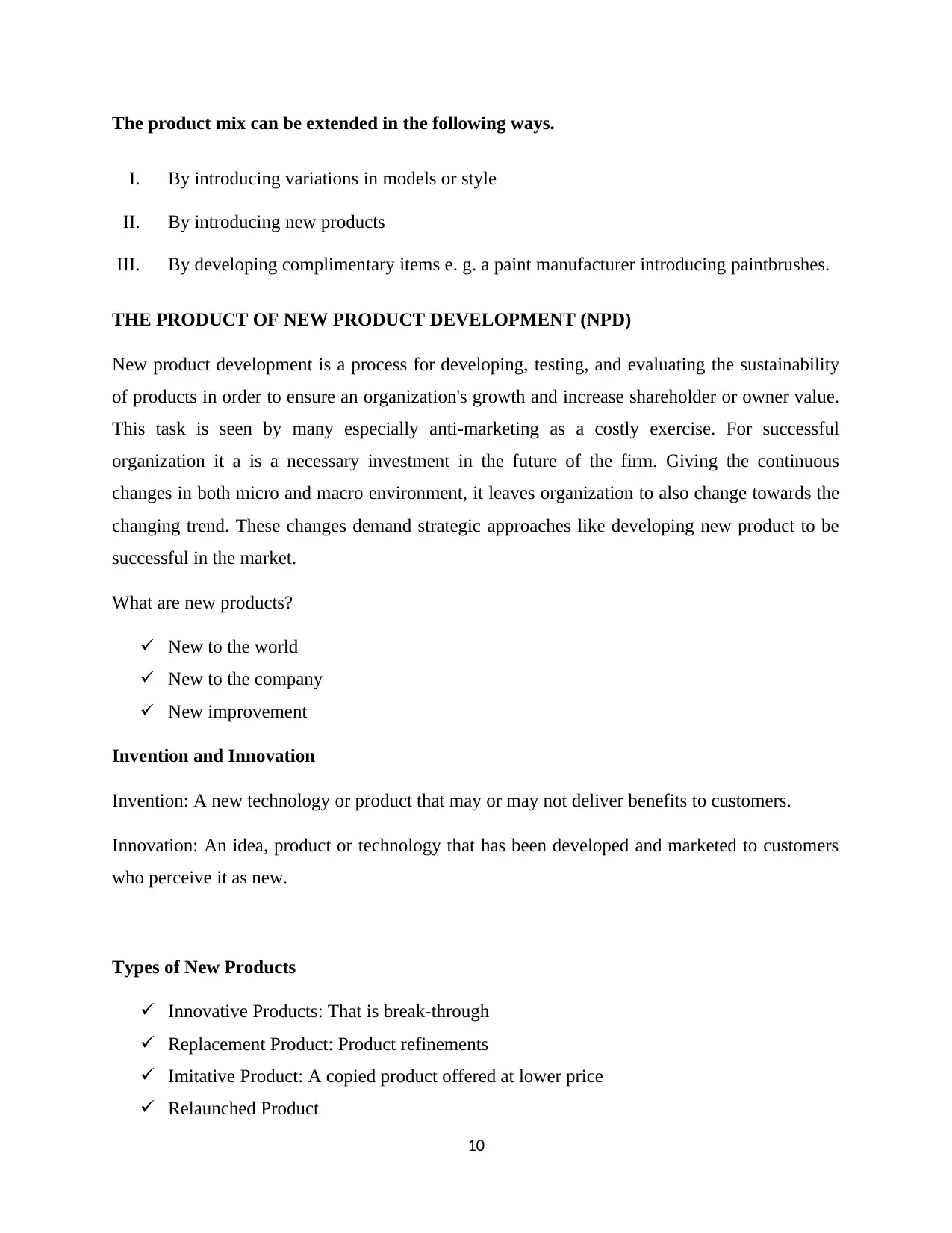
The product mix can be extended in the following ways.
I. By introducing variations in models or style
II. By introducing new products
III. By developing complimentary items e. g. a paint manufacturer introducing paintbrushes.
THE PRODUCT OF NEW PRODUCT DEVELOPMENT (NPD)
New product development is a process for developing, testing, and evaluating the sustainability
of products in order to ensure an organization's growth and increase shareholder or owner value.
This task is seen by many especially anti-marketing as a costly exercise. For successful
organization it a is a necessary investment in the future of the firm. Giving the continuous
changes in both micro and macro environment, it leaves organization to also change towards the
changing trend. These changes demand strategic approaches like developing new product to be
successful in the market.
What are new products?
New to the world
New to the company
New improvement
Invention and Innovation
Invention: A new technology or product that may or may not deliver benefits to customers.
Innovation: An idea, product or technology that has been developed and marketed to customers
who perceive it as new.
Types of New Products
Innovative Products: That is break-through
Replacement Product: Product refinements
Imitative Product: A copied product offered at lower price
Relaunched Product
10
I. By introducing variations in models or style
II. By introducing new products
III. By developing complimentary items e. g. a paint manufacturer introducing paintbrushes.
THE PRODUCT OF NEW PRODUCT DEVELOPMENT (NPD)
New product development is a process for developing, testing, and evaluating the sustainability
of products in order to ensure an organization's growth and increase shareholder or owner value.
This task is seen by many especially anti-marketing as a costly exercise. For successful
organization it a is a necessary investment in the future of the firm. Giving the continuous
changes in both micro and macro environment, it leaves organization to also change towards the
changing trend. These changes demand strategic approaches like developing new product to be
successful in the market.
What are new products?
New to the world
New to the company
New improvement
Invention and Innovation
Invention: A new technology or product that may or may not deliver benefits to customers.
Innovation: An idea, product or technology that has been developed and marketed to customers
who perceive it as new.
Types of New Products
Innovative Products: That is break-through
Replacement Product: Product refinements
Imitative Product: A copied product offered at lower price
Relaunched Product
10
Paraphrase This Document
Need a fresh take? Get an instant paraphrase of this document with our AI Paraphraser
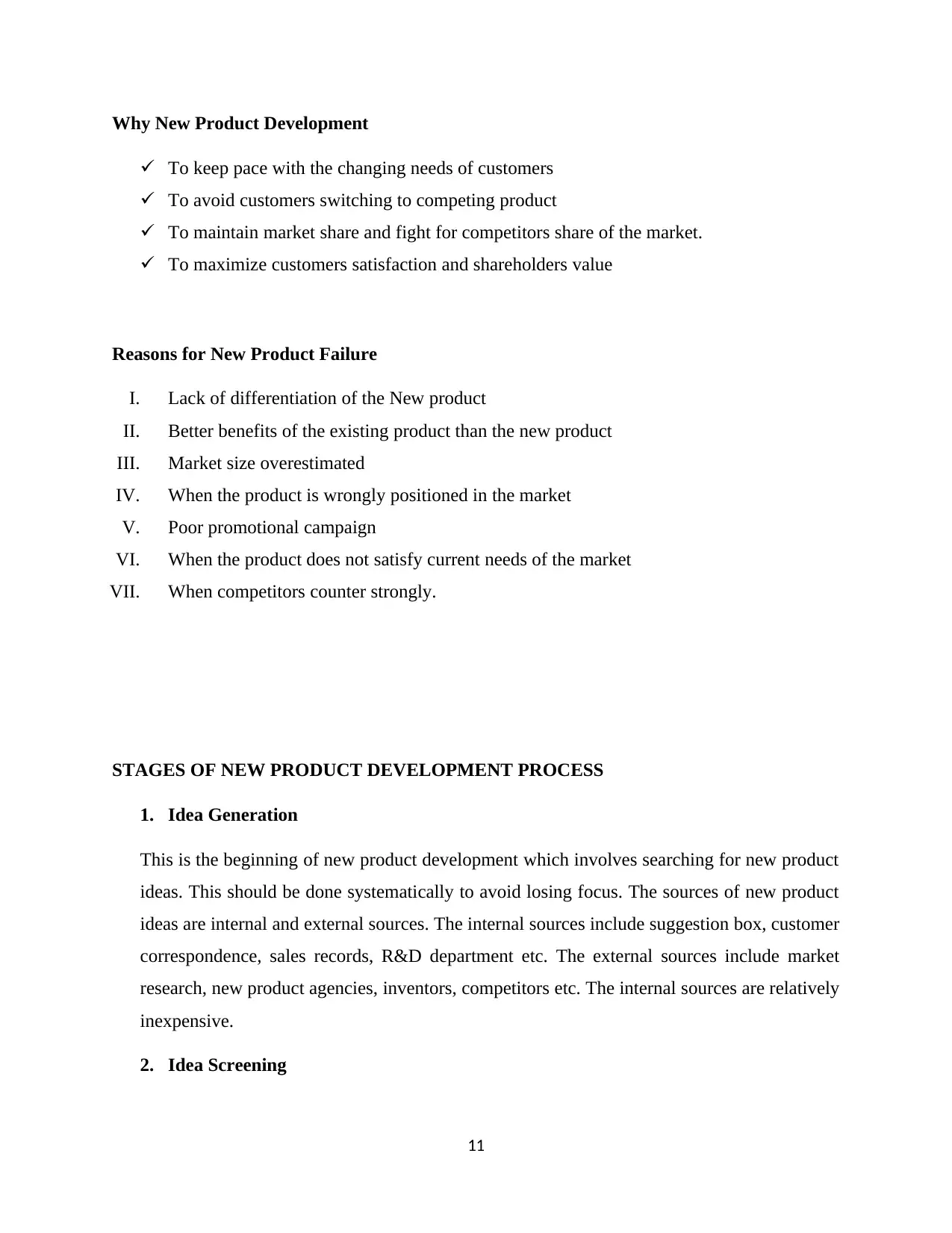
Why New Product Development
To keep pace with the changing needs of customers
To avoid customers switching to competing product
To maintain market share and fight for competitors share of the market.
To maximize customers satisfaction and shareholders value
Reasons for New Product Failure
I. Lack of differentiation of the New product
II. Better benefits of the existing product than the new product
III. Market size overestimated
IV. When the product is wrongly positioned in the market
V. Poor promotional campaign
VI. When the product does not satisfy current needs of the market
VII. When competitors counter strongly.
STAGES OF NEW PRODUCT DEVELOPMENT PROCESS
1. Idea Generation
This is the beginning of new product development which involves searching for new product
ideas. This should be done systematically to avoid losing focus. The sources of new product
ideas are internal and external sources. The internal sources include suggestion box, customer
correspondence, sales records, R&D department etc. The external sources include market
research, new product agencies, inventors, competitors etc. The internal sources are relatively
inexpensive.
2. Idea Screening
11
To keep pace with the changing needs of customers
To avoid customers switching to competing product
To maintain market share and fight for competitors share of the market.
To maximize customers satisfaction and shareholders value
Reasons for New Product Failure
I. Lack of differentiation of the New product
II. Better benefits of the existing product than the new product
III. Market size overestimated
IV. When the product is wrongly positioned in the market
V. Poor promotional campaign
VI. When the product does not satisfy current needs of the market
VII. When competitors counter strongly.
STAGES OF NEW PRODUCT DEVELOPMENT PROCESS
1. Idea Generation
This is the beginning of new product development which involves searching for new product
ideas. This should be done systematically to avoid losing focus. The sources of new product
ideas are internal and external sources. The internal sources include suggestion box, customer
correspondence, sales records, R&D department etc. The external sources include market
research, new product agencies, inventors, competitors etc. The internal sources are relatively
inexpensive.
2. Idea Screening
11
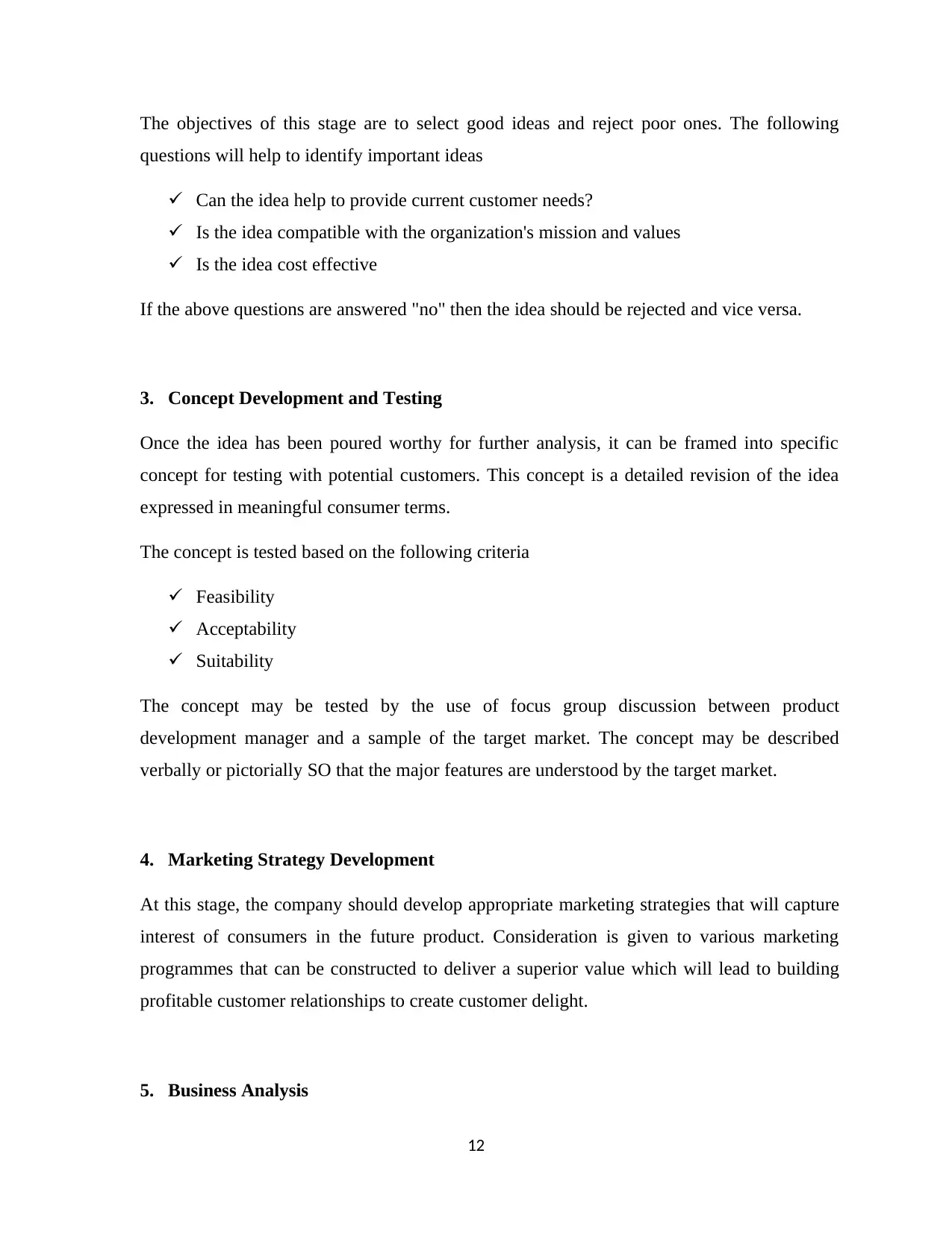
The objectives of this stage are to select good ideas and reject poor ones. The following
questions will help to identify important ideas
Can the idea help to provide current customer needs?
Is the idea compatible with the organization's mission and values
Is the idea cost effective
If the above questions are answered "no" then the idea should be rejected and vice versa.
3. Concept Development and Testing
Once the idea has been poured worthy for further analysis, it can be framed into specific
concept for testing with potential customers. This concept is a detailed revision of the idea
expressed in meaningful consumer terms.
The concept is tested based on the following criteria
Feasibility
Acceptability
Suitability
The concept may be tested by the use of focus group discussion between product
development manager and a sample of the target market. The concept may be described
verbally or pictorially SO that the major features are understood by the target market.
4. Marketing Strategy Development
At this stage, the company should develop appropriate marketing strategies that will capture
interest of consumers in the future product. Consideration is given to various marketing
programmes that can be constructed to deliver a superior value which will lead to building
profitable customer relationships to create customer delight.
5. Business Analysis
12
questions will help to identify important ideas
Can the idea help to provide current customer needs?
Is the idea compatible with the organization's mission and values
Is the idea cost effective
If the above questions are answered "no" then the idea should be rejected and vice versa.
3. Concept Development and Testing
Once the idea has been poured worthy for further analysis, it can be framed into specific
concept for testing with potential customers. This concept is a detailed revision of the idea
expressed in meaningful consumer terms.
The concept is tested based on the following criteria
Feasibility
Acceptability
Suitability
The concept may be tested by the use of focus group discussion between product
development manager and a sample of the target market. The concept may be described
verbally or pictorially SO that the major features are understood by the target market.
4. Marketing Strategy Development
At this stage, the company should develop appropriate marketing strategies that will capture
interest of consumers in the future product. Consideration is given to various marketing
programmes that can be constructed to deliver a superior value which will lead to building
profitable customer relationships to create customer delight.
5. Business Analysis
12
⊘ This is a preview!⊘
Do you want full access?
Subscribe today to unlock all pages.

Trusted by 1+ million students worldwide
1 out of 18
Related Documents
Your All-in-One AI-Powered Toolkit for Academic Success.
+13062052269
info@desklib.com
Available 24*7 on WhatsApp / Email
![[object Object]](/_next/static/media/star-bottom.7253800d.svg)
Unlock your academic potential
Copyright © 2020–2025 A2Z Services. All Rights Reserved. Developed and managed by ZUCOL.





